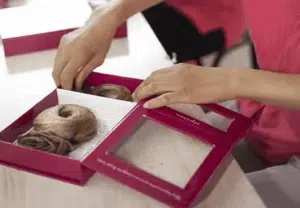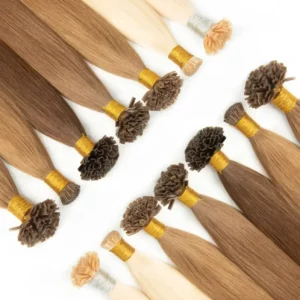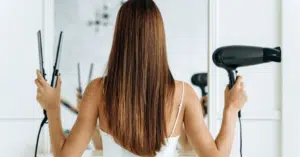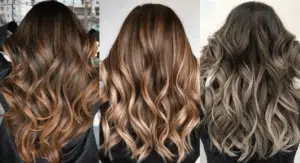Many stylists love the volume and flexibility of beaded weft extensions. But some worry: do they damage real hair over time?
Beaded weft extensions are not inherently bad for your hair—if installed correctly and maintained properly. Problems usually come from improper installation or neglect in care routines.
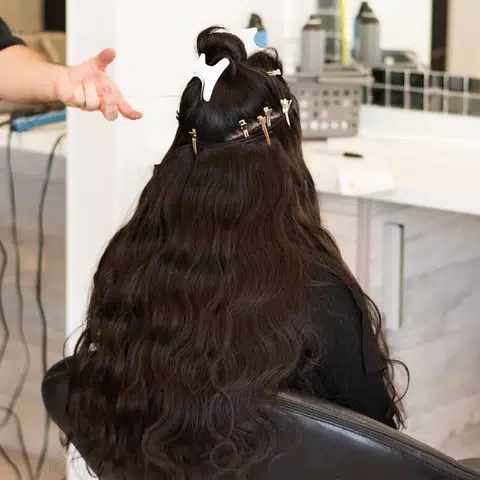
Let’s go deeper. If you’re a salon owner or hair professional considering beaded wefts for your clients or brand, read on to get the full picture.
What Are Beaded Weft Extensions?
Beaded weft extensions are a popular semi-permanent method that combines a weft of hair with small silicone-lined beads to attach the weft to the natural hair without glue or heat.
Beaded wefts provide volume, flexibility, and reusability. They can be installed in rows, making them a favorite for stylists who want efficient applications and removals.
Advantages of Beaded Weft Extensions
No heat or glue required
Installation uses microbeads to clamp wefts onto natural hair—no adhesive or heating tools needed.
Reusable hair
High-quality beaded wefts like ours can be reused multiple times, with proper care.
Scalp breathability
They leave more room between the weft and scalp, which allows better airflow and comfort.
Flexible styling
Ideal for clients who want to wear their hair up or switch parts without revealing bonds.

Disadvantages of Beaded Weft Extensions
Not ideal for thin or weak hair
Clients with fragile or fine strands might experience tension or breakage if beads are installed too tightly.
Regular maintenance needed
Beaded rows need repositioning every 6–8 weeks. Neglecting this can cause matting or hair stress.
Potential bead slipping
If beads are not installed securely, they can loosen or slip out.
Visible rows in thin areas
If not installed skillfully, the beaded row can show—especially in clients with fine or light hair density.

Are Beaded Weft Extensions Bad for Your Hair?
Some clients feel hair thinning after wearing extensions. But does that mean beaded wefts are harmful?
Beaded weft extensions do not damage natural hair when applied by a trained professional and maintained properly. The damage risks come from poor technique, incorrect tension, or neglect.
Common Damage Causes (Not the Extensions Themselves)
1. Poor installation technique
If beads are clamped too tightly, they pull on roots and cause stress. If they’re too loose, the weft slides and tangles.
2. Inadequate aftercare
Clients who don’t brush properly or sleep without protection can stress both the beads and their real hair.
3. Wrong hair type match
Using heavy wefts on fine hair creates imbalance. Professionals should always assess natural hair density before recommending this method.
4. Skipping maintenance appointments
Beads slide down naturally over time. Waiting too long between repositions can cause matting or breakage near the scalp.
What Can Professionals Do?
- Always perform a strand test.
- Use full cuticle, lightweight wefts for balance.
- Apply minimal tension during clamping.
- Educate clients on home care routines.
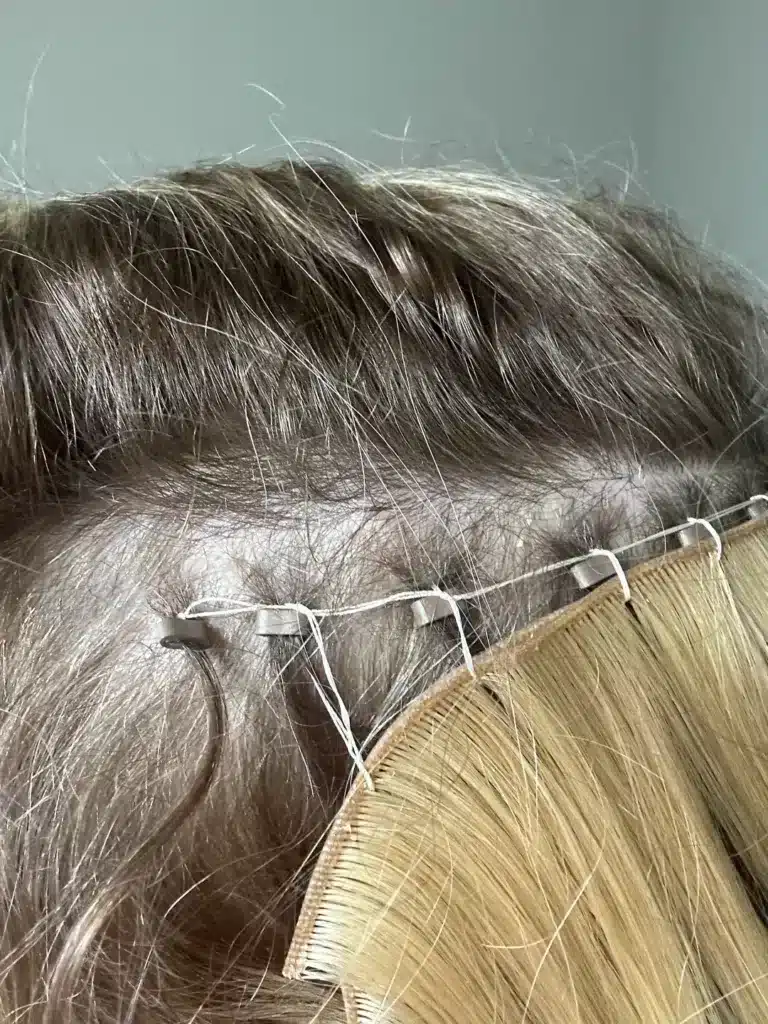
How to Care for Beaded Weft Extensions?
To extend the lifespan of beaded weft extensions and protect natural hair, clients must follow a consistent care routine.
1. Brushing and Detangling
Use a loop brush or soft bristle brush. Hold the base of the weft while brushing to reduce tension on beads. Brush 2–3 times daily to prevent tangles.
2. Washing and Conditioning
Use sulfate-free shampoo. Focus shampoo on the scalp and conditioner on the mid-shaft to ends—avoid beads and roots directly. Dry thoroughly to avoid mildew at the weft.
3. Sleep Protection
Clients should tie hair into a loose braid or ponytail before bed. Use silk or satin pillowcases to reduce friction.
4. Avoiding Heavy Oils and Products
Avoid placing heavy oils or alcohol-based products near the beads, as these can weaken grip or cause slipping.
How Long Do Beaded Weft Extensions Last?
The longevity of beaded weft extensions depends on hair quality, daily care, and frequency of repositioning.
General Lifespan Guidelines
- Weft hair lifespan: 6–12 months with quality hair (Hibiscus Hair offers 12–18 months with proper care)
- Installation lifespan: 6–8 weeks before beads need moving
- Number of reinstalls: Up to 4–6 times depending on condition
What Shortens Their Lifespan?
- Improper brushing
- Sleeping with wet hair
- Skipping maintenance appointments
- Poor-quality hair
Professional Tip
Use full cuticle hair extensions for best results. Hibiscus Hair’s hand-tied and genius wefts are designed to withstand multiple reuses while maintaining softness and strength.

How to Make Beaded Weft Extensions Last Longer?
Your client’s hair extensions should last at least 12 months. But how?
1. Schedule Regular Maintenance
Move-up appointments every 6–8 weeks prevent bead slippage and tangling.
2. Use Professional Products
Recommend sulfate-free, extension-safe products. Leave-in conditioners and thermal protectants are essential.
3. Air-Dry When Possible
Heat styling shortens lifespan. Encourage air-drying or use low heat settings.
4. Storage and Resting Periods
If clients remove the extensions between installs, store them in a clean, dry bag. A short break between installs can also help hair rest.
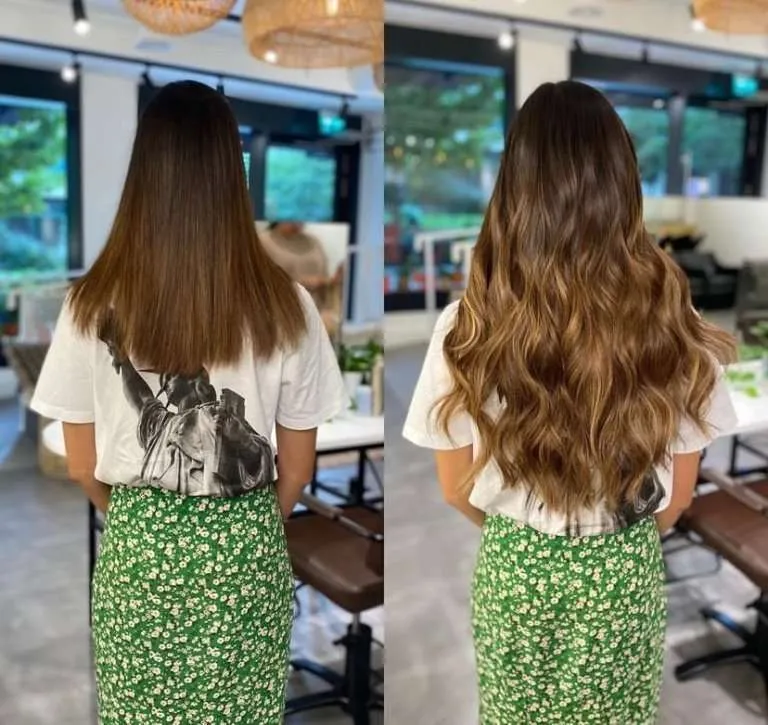
My Opinion
Beaded wefts are not harmful by nature. I’ve seen salons achieve stunning results using this method—especially when they choose lightweight, full cuticle wefts and focus on client education.
At Hibiscus Hair, we manufacture our wefts with one goal: safe, stylish, and long-lasting performance for salons and brands who refuse to compromise. We recommend beaded weft installs only for clients with medium to thick natural hair. With proper installation, the hair stays healthy and reusable—just as it should be.
FAQ
Q1: Can clients with thin hair wear beaded wefts?
A: Not recommended. Beads may put pressure on fragile strands. Tape-ins or K-tips are often safer.
Q2: How often should clients wash beaded extensions?
A: 1–2 times a week is ideal. Too much washing leads to faster wear and bead loosening.
Q3: Are beaded extensions better than tape-ins?
A: It depends. Beaded wefts are more breathable and reusable. Tape-ins are flatter and better for thin hair.
Q4: Can I color the extensions?
A: Yes—if using 100% full cuticle hair. But always color before installation to avoid bead disruption.
Q5: What if the beads slip?
A: Visit your stylist for repositioning. Avoid pulling or adjusting on your own.
Conclusion
Beaded weft extensions are safe and effective—when done right. Technique, quality, and care matter most.

